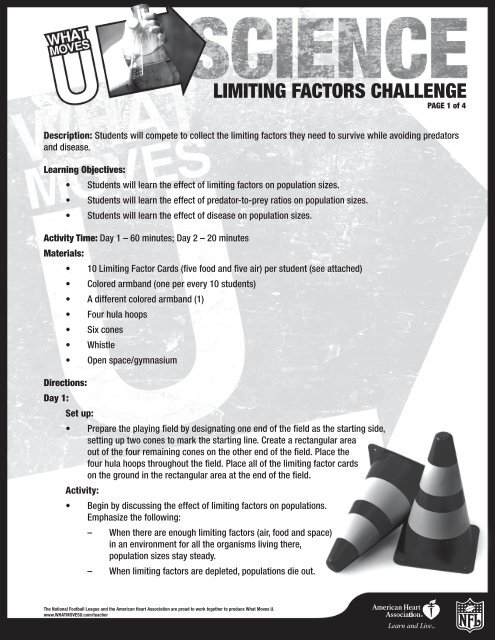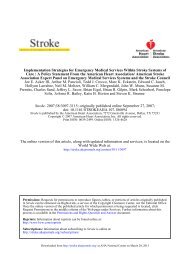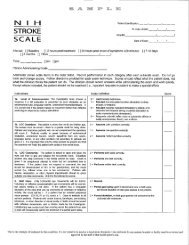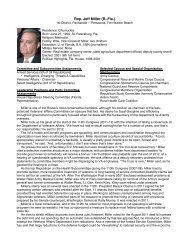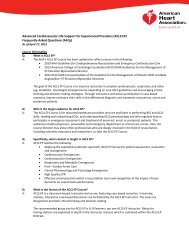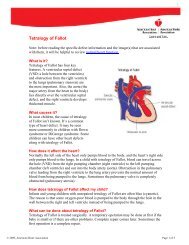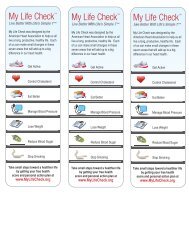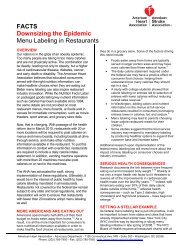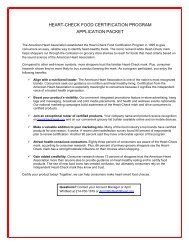LIMITING FACTORS CHALLENGE - American Heart Association
LIMITING FACTORS CHALLENGE - American Heart Association
LIMITING FACTORS CHALLENGE - American Heart Association
You also want an ePaper? Increase the reach of your titles
YUMPU automatically turns print PDFs into web optimized ePapers that Google loves.
<strong>LIMITING</strong> <strong>FACTORS</strong> <strong>CHALLENGE</strong><br />
PAGE 1 of 4<br />
Description: Students will compete to collect the limiting factors they need to survive while avoiding predators<br />
and disease.<br />
Learning Objectives:<br />
• Students will learn the effect of limiting factors on population sizes.<br />
• Students will learn the effect of predator-to-prey ratios on population sizes.<br />
• Students will learn the effect of disease on population sizes.<br />
Activity Time: Day 1 – 60 minutes; Day 2 – 20 minutes<br />
Materials:<br />
Directions:<br />
Day 1:<br />
• 10 Limiting Factor Cards (five food and five air) per student (see attached)<br />
• Colored armband (one per every 10 students)<br />
• A different colored armband (1)<br />
• Four hula hoops<br />
• Six cones<br />
• Whistle<br />
• Open space/gymnasium<br />
Set up:<br />
• Prepare the playing field by designating one end of the field as the starting side,<br />
setting up two cones to mark the starting line. Create a rectangular area<br />
out of the four remaining cones on the other end of the field. Place the<br />
four hula hoops throughout the field. Place all of the limiting factor cards<br />
on the ground in the rectangular area at the end of the field.<br />
Activity:<br />
• Begin by discussing the effect of limiting factors on populations.<br />
Emphasize the following:<br />
– When there are enough limiting factors (air, food and space)<br />
in an environment for all the organisms living there,<br />
population sizes stay steady.<br />
– When limiting factors are depleted, populations die out.<br />
The National Football League and the <strong>American</strong> <strong>Heart</strong> <strong>Association</strong> are proud to work together to produce What Moves U.<br />
www.WHATMOVESU.com/teacher
<strong>LIMITING</strong> <strong>FACTORS</strong> <strong>CHALLENGE</strong><br />
PAGE 2 of 4<br />
– When the ratio of predators to prey in an environment increases, the prey population declines<br />
more quickly. Disease is a natural way for population sizes to stay in check.<br />
– If a population is not reproducing, depleted limiting factors, increased predator-to-prey ratios,<br />
and disease will eventually wipe out the population.<br />
Select students to be predators (about one predator for every 10 students is needed). Give them a colored<br />
armband to wear. Assign one student to be “disease.” Give him or her the other colored armband. All other<br />
students will be prey.<br />
• The goal of the game is for every prey to start at the starting line and run across the field to get five<br />
food cards and bring them back to the starting line and then get five air cards and bring them back<br />
to the starting line. (The students must make two trips from the starting line to the rectangular area<br />
and back.) They may grab only one type of card at a time (i.e., air or food), but they may grab more<br />
than one of that type of card at a time.<br />
• If the prey are tagged by a predator or disease, they are out.<br />
• If the prey are about to get tagged by a predator or disease, but they are near a hula hoop, prey<br />
may step inside the circle to get 10 seconds of safe time. If a prey is in the hula hoop for more than<br />
10 seconds, he or she is out. The rectangle containing the limiting factor cards is also a safe zone,<br />
where prey cannot be tagged.<br />
• After five to 10 minutes, depending on the kids’ energy levels, blow the whistle to end the round.<br />
Take a count to see how many prey have made it back to the starting line with five food cards and<br />
then five air cards without being tagged by a predator or disease. They have survived to make it to<br />
the next round. Students who did not survive will be named judges, helping you enforce the rules.<br />
• Take away two food and two air cards for every prey that originally began the game. The rest of the<br />
cards go back into the rectangular area at the ending line.<br />
• Play will continue with the prey who survived the first round. This round will be more<br />
difficult because there will not be enough limiting factors for everyone.<br />
As before, prey who get tagged by predators or disease will be out. At the<br />
end of the round, take a final count of prey who have survived by getting<br />
back to the starting line with five food cards and then five air cards.<br />
• For the final round, remove all but one hula hoop from the field,<br />
and take away one more food and one more air card for every prey<br />
that originally began the game. Play resumes with prey that have<br />
survived the first two rounds. End the round when you have<br />
10 minutes of class time left.<br />
• Conduct a quick discussion of what happened during<br />
the game, pointing out what happened to the prey when<br />
the limiting factors decreased.<br />
The National Football League and the <strong>American</strong> <strong>Heart</strong> <strong>Association</strong> are proud to work together to produce What Moves U.<br />
www.WHATMOVESU.com/teacher
Day 2:<br />
• During class, discuss the science behind the activity. Discuss how what happened during<br />
the activity shows how limiting factors control a population; if a population gets too big,<br />
the environment naturally decreases that population. Point out that when the ratio of<br />
predators to prey in an environment increases (as more students dropped out of the game),<br />
the prey population declines more quickly. Disease is also a natural way for population<br />
sizes to stay in check.<br />
Extend the Activity: Have students journal what they learned through this activity.<br />
Modification: Allow for shorter playing time and complete the activity and discussion in one day.<br />
Note: Could be team taught with physical education teacher.<br />
Submitted by Maria Boulmetis, Flat River Middle School, Coventry, Rhode Island<br />
Correlation to National Curriculum Standards:<br />
Correlation to National Curriculum Standards:<br />
Content Standard B:<br />
• Structure and function of living things<br />
• Populations and ecosystems<br />
Content Standard F:<br />
• Populations, resources and environments<br />
From NSES http://newton.nap.edu/html/nses/6d.html#csa58<br />
<strong>LIMITING</strong> <strong>FACTORS</strong> <strong>CHALLENGE</strong><br />
PAGE 3 of 4<br />
The National Football League and the <strong>American</strong> <strong>Heart</strong> <strong>Association</strong> are proud to work together to produce What Moves U.<br />
www.WHATMOVESU.com/teacher
<strong>LIMITING</strong> <strong>FACTORS</strong> <strong>CHALLENGE</strong><br />
PAGE 4 of 4<br />
FOOD<br />
FOOD<br />
FOOD<br />
FOOD<br />
FOOD<br />
AIR<br />
AIR<br />
AIR<br />
AIR<br />
AIR<br />
The National Football League and the <strong>American</strong> <strong>Heart</strong> <strong>Association</strong> are proud to work together to produce What Moves U.<br />
www.WHATMOVESU.com/teacher


